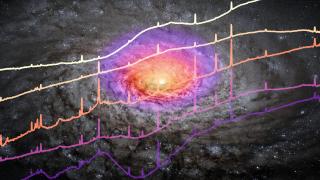Bibcode
Rouan, Daniel; Hönig, Sebastian; Izumi, Takuma; Haidar, Houda; Fuller, Lindsay; Delaney, Dan; Esparza-Arredondo, Donaji; Ward, Martin J.; Rosario, David J.; Stalevski, Marko; Rigopoulou, Dimitra; Ricci, Claudio; Levenson, Nancy A.; Ramos Almeida, Cristina; Labiano, Alvaro; Leist, Mason T.; Imanishi, Masatoshi; González-Martín, Omaira; García-Lorenzo, Begoña; Gandhi, Poshak; García-Burillo, Santiago; Díaz-Santos, Tanio; Bunker, Andrew J.; Combes, Francoise; Bellocchi, Enrica; López-Rodríguez, Enrique; Audibert, Anelise; Pereira-Santaella, Miguel; Hermosa Muñoz, Laura; García-Bernete, Ismael; Shimizu, Taro T.; Alonso-Herrero, Almudena; Davies, Ric I.; Hicks, Erin K. S.; Zhang, Lulu; Packham, Chris
Bibliographical reference
The Astrophysical Journal
Advertised on:
10
2024
Journal
Citations
26
Refereed citations
20
Description
Utilizing JWST MIRI/Medium Resolution Spectrograph integral field unit observations of the kiloparsec-scale central regions, we showcase the diversity of ionized gas distributions and kinematics in six nearby Seyfert galaxies included in the GATOS survey. Specifically, we present spatially resolved flux distribution and velocity field maps of six ionized emission lines covering a large range of ionization potentials (15.8–97.1 eV). Based on these maps, we showcase the evidence of ionized gas outflows in the six targets, and find some highly disturbed regions in NGC 5728, NGC 5506, and ESO137-G034. We propose active galactic nucleus (AGN)-driven radio jets plausibly play an important role in triggering these highly disturbed regions. With the outflow rates estimated based on [Ne V] emission, we find the six targets tend to have ionized outflow rates converged to a narrower range than the previous finding. These results have an important implication for the outflow properties in AGN of comparable luminosity.
Related projects

Nuclear Activity in Galaxies: a 3D Perspective from the Nucleus to the Outskirts
This project consists of two main research lines. First, the study of quasar-driven outflows in luminous and nearby obscured active galactic nuclei (AGN) and the impact that they have on their massive host galaxies (AGN feedback). To do so, we have been granted time with the Gran Telescopio CANARIAS (GTC) in the optical and near-infrared ranges
Cristina
Ramos Almeida